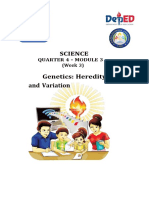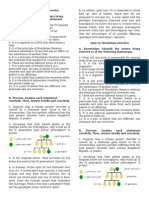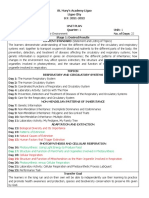0 ratings0% found this document useful (0 votes)
55 viewsIB Biology Genetics Questions (IB Topic 3) : For Mader 10 Edition
IB Biology Genetics Questions (IB Topic 3) : For Mader 10 Edition
Uploaded by
manrajThis document contains a list of 42 genetics questions covering topics such as defining key genetics terms, Punnett squares, pedigree charts, blood types, sickle cell disease, sex-linked traits, recombinant DNA, PCR, gel electrophoresis, DNA profiling, genetic screening, transgenic organisms, cloning, and the Human Genome Project.
Copyright:
© All Rights Reserved
Available Formats
Download as DOC, PDF, TXT or read online from Scribd
IB Biology Genetics Questions (IB Topic 3) : For Mader 10 Edition
IB Biology Genetics Questions (IB Topic 3) : For Mader 10 Edition
Uploaded by
manraj0 ratings0% found this document useful (0 votes)
55 views2 pagesThis document contains a list of 42 genetics questions covering topics such as defining key genetics terms, Punnett squares, pedigree charts, blood types, sickle cell disease, sex-linked traits, recombinant DNA, PCR, gel electrophoresis, DNA profiling, genetic screening, transgenic organisms, cloning, and the Human Genome Project.
Original Title
Genetics Questions - New 3
Copyright
© © All Rights Reserved
Available Formats
DOC, PDF, TXT or read online from Scribd
Share this document
Did you find this document useful?
Is this content inappropriate?
This document contains a list of 42 genetics questions covering topics such as defining key genetics terms, Punnett squares, pedigree charts, blood types, sickle cell disease, sex-linked traits, recombinant DNA, PCR, gel electrophoresis, DNA profiling, genetic screening, transgenic organisms, cloning, and the Human Genome Project.
Copyright:
© All Rights Reserved
Available Formats
Download as DOC, PDF, TXT or read online from Scribd
Download as doc, pdf, or txt
0 ratings0% found this document useful (0 votes)
55 views2 pagesIB Biology Genetics Questions (IB Topic 3) : For Mader 10 Edition
IB Biology Genetics Questions (IB Topic 3) : For Mader 10 Edition
Uploaded by
manrajThis document contains a list of 42 genetics questions covering topics such as defining key genetics terms, Punnett squares, pedigree charts, blood types, sickle cell disease, sex-linked traits, recombinant DNA, PCR, gel electrophoresis, DNA profiling, genetic screening, transgenic organisms, cloning, and the Human Genome Project.
Copyright:
© All Rights Reserved
Available Formats
Download as DOC, PDF, TXT or read online from Scribd
Download as doc, pdf, or txt
You are on page 1of 2
IB Biology Genetics Questions (IB Topic 3) for Mader 10th edition
1. Define: gene, genome, allele, and loci (singular “locus”).
2. What are the two molecular components of chromosomes?
3. Define: dominant allele, recessive allele, genotype, phenotype, homozygous, and
heterozygous.
4. What is the difference between the genotype and the phenotype of an individual?
5. Do Practice Problems 1 (p. 468).
6. What is a Punnett square?
7. What is a testcross and when is it useful?
8. Do Practice Problems 2 (p. 470).
9. What are the expected results of these crosses: homozygous dominant X homozygous
recessive; homozygous dominant X heterozygous; heterozygous X heterozygous;
heterozygous X homozygous recessive? Which of these are a testcross?
10. Define: autosome, autosomal recessive, autosomal dominant, and carrier.
11. What is a pedigree chart and when is it used?
12. Construct a pedigree chart of widow’s peak hairlines in an extended family using the
following information: The grandfather has a widow’s peak. The grandmother doesn’t.
Their two sons have widow’s peaks, but their daughter doesn’t. One son marries a woman
with a widow’s peak and they have two boys with widow’s peaks. The other son marries a
woman with a straight hairline and they have two boys with straight hairlines. The
daughter marries a man who has a widow’s peak and they have two girls, one with a
widow’s peak and one without. Is widow’s peak a dominant or recessive trait? Identify as
many of the genotypes of the family members as you can.
13. Do Practice Problems 4 (p. 475) and 5 (p. 476).
14. Explain multiple alleles and codominance. How are the ABO blood groupings an example
of these?
15. Do Practice Problems 6, # 3 and 4 (p. 478).
16. Review sickle-cell disease. What kind of mutation causes the defective hemoglobin?
What advantage does the heterozygous condition confer? What is the relationship
between the frequency of the sickle-cell allele and the distribution of malaria?
17. A man and a woman both have sickle-cell trait. What are their chances of having a child
who has sickle-cell disease? who has sickle-cell trait? who is normal?
18. Read “Summarizing the Concepts” p. 480; Do “Testing Yourself” #3, 5, 6, 8 – 13, 15, 16 p.
481; “Additional Genetics Problems” #1, 2, 7 p. 481.
19. Describe karyotyping and give one application of it.
20. Describe non-disjunction and explain how this can result in Down syndrome.
21. What are the sex chromosomes? Which of these are found in an egg and which in a
sperm?
22. Define sex linkage.
23. Describe the sex-linked disorders of colour blindness and hemophilia.
24. Can females be either homozygous or heterozygous for a sex-linked gene? Can males be
either homozygous or heterozygous for a sex-linked gene?
25. Can a carrier be male or female? Is a carrier homozygous or heterozygous?
26. Why are sex-linked disorders more common in males?
27. Do Practice Problems # 1, 2, and 3 on p. 494.
28. Read “Summarizing the Concepts” p. 498; Do “Testing Yourself” #7, 10, 12, 13, 16 - 18 p.
498 – 499; “Additional Genetics Problems” #1 – 7 p. 499
29. What is recombinant DNA (rDNA)? Describe the procedure used to create rDNA.
Include the terms plasmids, restriction enzymes, ligase, and host cells.
30. What is PCR and what does it do?
31. What does gel electrophoresis do and how is it used in DNA profiling (DNA
fingerprinting)?
32. Describe two uses of DNA profiling.
33. What is genetic screening?
34. Discuss three advantages and/or disadvantages of genetic screening.
35. Give two examples of the current uses of transgenic organisms (genetically modified
plants or animals). Discuss the potential benefits and possible harmful effects for one
of these.
36. Define clone.
37. Outline the technique used for cloning animals such as Dolly the sheep.
38. Discuss the ethical issues of cloning humans.
39. What is the Human Genome Project?
40. What are three possible positive outcomes of this project?
41. Describe the process of gene therapy for a genetic disease such as SCID.
42. Read “Summarizing the Concepts” p. 535; Do “Testing Yourself” #1 – 5, 7 – 9, 12 -17 p.
536
You might also like
- Could This Be Magic? Tattooing As Liberation WorkDocument68 pagesCould This Be Magic? Tattooing As Liberation Workem100% (1)
- Worksafe Blood Culture Collection Procedure 1brochDocument1 pageWorksafe Blood Culture Collection Procedure 1brochNidia Maradiaga100% (1)
- Intro To Genetics WebQuestDocument3 pagesIntro To Genetics WebQuestFRANKLIN Ofori100% (2)
- Genetics ProblemsDocument14 pagesGenetics Problemsafaflotfi_1556964590% (2)
- O Level Biology Practice Questions And Answers: Heredity And Molecular GeneticsFrom EverandO Level Biology Practice Questions And Answers: Heredity And Molecular GeneticsNo ratings yet
- Assessment ProtocolDocument19 pagesAssessment Protocolapi-437360672No ratings yet
- Genetics #2worksheetsDocument8 pagesGenetics #2worksheetsandrewericjensonNo ratings yet
- Yr10 Biology Revision GuideDocument9 pagesYr10 Biology Revision Guideanas.amr.abdullahNo ratings yet
- Review Cell DivisionDocument3 pagesReview Cell Divisionamrithaa logeswaranNo ratings yet
- Copy of Isabella Licata - Biotechnology ProjectDocument23 pagesCopy of Isabella Licata - Biotechnology Projectjh3283017No ratings yet
- SCIENCE-8 - Q4-Week 3 Mendelian GeneticsDocument20 pagesSCIENCE-8 - Q4-Week 3 Mendelian Geneticsjomarie estibal100% (1)
- Remediation Packet - Spring Semester 2 by Michael AcostaDocument6 pagesRemediation Packet - Spring Semester 2 by Michael AcostaFlozieNo ratings yet
- Exam Review - Jan 2012Document3 pagesExam Review - Jan 2012Ms Ratna Lestyana DewiNo ratings yet
- ReadingAssignmentfor - Chapter14 DoneDocument2 pagesReadingAssignmentfor - Chapter14 Donejack rockNo ratings yet
- Lab Activity #10 BIO 113Document2 pagesLab Activity #10 BIO 113Jahnille VerdisNo ratings yet
- UNIT 3 - Genetics and Heredity Basic GeneticsDocument11 pagesUNIT 3 - Genetics and Heredity Basic GeneticsTristan ScottNo ratings yet
- Genetics QuestionsDocument3 pagesGenetics Questionsa spelluNo ratings yet
- And Variation Genetics: Heredity: ScienceDocument15 pagesAnd Variation Genetics: Heredity: ScienceMichelle Casayuran - Regala100% (2)
- Understandings, Applications and Skills (This Is What You Maybe Assessed On)Document15 pagesUnderstandings, Applications and Skills (This Is What You Maybe Assessed On)SophiaNo ratings yet
- Ch-5 - Principles of Inheritance - ASSIGNMENTDocument4 pagesCh-5 - Principles of Inheritance - ASSIGNMENTReet SabharwalNo ratings yet
- heredity worksheetDocument3 pagesheredity worksheetasha87sandhuNo ratings yet
- Unit C ExamDocument18 pagesUnit C Examapi-199149636No ratings yet
- Solutions Manual Chapter 03Document28 pagesSolutions Manual Chapter 03Duy Pham TruongNo ratings yet
- Assignment-1 Genetics 341Document4 pagesAssignment-1 Genetics 341damionsimmons10No ratings yet
- 361 13patilDocument5 pages361 13patilJeet SarkarNo ratings yet
- Method and Practice in Biological Anthropology 1st Edition Hens Solutions ManualDocument13 pagesMethod and Practice in Biological Anthropology 1st Edition Hens Solutions Manualjamesmartinezstzejixmcg100% (19)
- BIOLOGY CLASS 10 CH 2 GENETICS QUESTION BANKDocument1 pageBIOLOGY CLASS 10 CH 2 GENETICS QUESTION BANKthanishnalla0987No ratings yet
- Study Guide Exam1Document3 pagesStudy Guide Exam1Lizzy HoustonNo ratings yet
- Exercise 1-3Document9 pagesExercise 1-3Patricia MedinaNo ratings yet
- 2019 BIOL 1308 Exam 2 Review-1Document4 pages2019 BIOL 1308 Exam 2 Review-1JamesroycazaresNo ratings yet
- Assignment Unit - 7, Genetics and EvolutionDocument1 pageAssignment Unit - 7, Genetics and EvolutionNikhil MishraNo ratings yet
- 361 13patilDocument5 pages361 13patilAbdul MananNo ratings yet
- Recuperation Workshop Science 9th GradeDocument5 pagesRecuperation Workshop Science 9th GradeJUAN CAMILO JIMENEZNo ratings yet
- File 3756Document23 pagesFile 3756jh3283017No ratings yet
- Unit 6 Hereditypart 1Document13 pagesUnit 6 Hereditypart 1Umer26450% (1)
- Exam Review Sbi3u June 2017b2Document7 pagesExam Review Sbi3u June 2017b2BrandonLiNo ratings yet
- CLASS XII (Question Bank) 2015-16Document6 pagesCLASS XII (Question Bank) 2015-16Somnath PandeyNo ratings yet
- Important Numericals From ChaptersDocument10 pagesImportant Numericals From ChaptersSwastik DasNo ratings yet
- Genetics: Which Two Are Most Likely Related and Why?Document15 pagesGenetics: Which Two Are Most Likely Related and Why?HenriNo ratings yet
- 6 Gene Mapping and ComplemetationDocument21 pages6 Gene Mapping and ComplemetationPrem ShuklaNo ratings yet
- Prob PDFDocument12 pagesProb PDFwallace120No ratings yet
- Principles of Inheritance Molecular Basis of Inheritance: Genetics - IDocument2 pagesPrinciples of Inheritance Molecular Basis of Inheritance: Genetics - ISouparna GhoshNo ratings yet
- Research Papers On Molecular Genetics PDFDocument7 pagesResearch Papers On Molecular Genetics PDFafmclccre100% (1)
- SCU BIOL18 Midterm Study GuideDocument3 pagesSCU BIOL18 Midterm Study GuidePaige RichardsNo ratings yet
- Biology Final Exam Study GuideDocument8 pagesBiology Final Exam Study Guideapi-236677776No ratings yet
- Biology ChallengeDocument7 pagesBiology ChallengeSciOlympiad234550% (2)
- 2023 - Science 9 Exam ReviewDocument14 pages2023 - Science 9 Exam ReviewZunairah AdnanNo ratings yet
- Std. XII Biology Question BankDocument67 pagesStd. XII Biology Question BankShashank RautNo ratings yet
- Holidays Homework BIOLOGY CLASS 12 (2024)Document3 pagesHolidays Homework BIOLOGY CLASS 12 (2024)Jyoti JoshiNo ratings yet
- Thesis EpigeneticsDocument5 pagesThesis Epigeneticsaparnaharrisonstamford100% (2)
- 1Document47 pages1Jason NguyenNo ratings yet
- Assignment 03 Henry PriceDocument2 pagesAssignment 03 Henry PriceHenry PriceNo ratings yet
- 361 13patilDocument5 pages361 13patilTanveer SultanNo ratings yet
- Lacerna, Roselyn T. Lab Activity WorksheetDocument6 pagesLacerna, Roselyn T. Lab Activity WorksheetRoselyn LacernaNo ratings yet
- B11 InheritanceDocument34 pagesB11 InheritanceVincey LuNo ratings yet
- APBIO 8.7 WorksheetDocument5 pagesAPBIO 8.7 Worksheetcarolagianserra06No ratings yet
- VCE BIOLOGY UnitDocument24 pagesVCE BIOLOGY Unitjess_heathNo ratings yet
- 10th Week InheritanceDocument9 pages10th Week InheritanceJude Daniel AquinoNo ratings yet
- Quiz On Mendelian GeneticsDocument2 pagesQuiz On Mendelian GeneticsslytheraineNo ratings yet
- Genetics Test Study GuideDocument4 pagesGenetics Test Study Guideapi-233736029No ratings yet
- ASRM (2013) Epigenetic Disorders and Male Subfertility PDFDocument8 pagesASRM (2013) Epigenetic Disorders and Male Subfertility PDFGerardo Solano-ElizondoNo ratings yet
- Module in GeneticsDocument48 pagesModule in GeneticsWilma TorinoNo ratings yet
- Clariant SDS GENAPOL G 260 Indonesia EnglishDocument10 pagesClariant SDS GENAPOL G 260 Indonesia EnglishrezkyNo ratings yet
- 1coherence and Cohesion Text EDITADODocument3 pages1coherence and Cohesion Text EDITADOcristinabaleaniNo ratings yet
- Family Nurse ContactDocument10 pagesFamily Nurse Contactphoebe100% (4)
- Urology Case ReportsDocument3 pagesUrology Case ReportsEdo Bagus TantyoNo ratings yet
- Microbes in Human Welfare, Diagram + Matching Type Qs-1Document31 pagesMicrobes in Human Welfare, Diagram + Matching Type Qs-1rajeshwariNo ratings yet
- Corporate Social Responsibility Implementation in India: Opportunities and ChallengesDocument9 pagesCorporate Social Responsibility Implementation in India: Opportunities and ChallengesKanha muduliNo ratings yet
- Errata - Lange Q&A Surgery 5th EdDocument1 pageErrata - Lange Q&A Surgery 5th Edginadaislu100% (2)
- A Practical Guide To Happiness in Children and Teens On The Autism Spectrum - A Positive Psychology Approach (2017)Document185 pagesA Practical Guide To Happiness in Children and Teens On The Autism Spectrum - A Positive Psychology Approach (2017)arlene ABANo ratings yet
- iMTA Valuation of Informal Care QuestionnaireDocument51 pagesiMTA Valuation of Informal Care QuestionnaireJob van ExelNo ratings yet
- Abate MSDSDocument10 pagesAbate MSDS缪忠琴No ratings yet
- Support Irrigation WorkDocument20 pagesSupport Irrigation Workmezgebu abate100% (1)
- 1 Kullyat e Advia PDFDocument9 pages1 Kullyat e Advia PDFMd ÀrmàâñNo ratings yet
- Ipr Case StudyDocument12 pagesIpr Case Studypmprerna100% (5)
- Supplementary Feeding Records Stock-0420247060676673Document4 pagesSupplementary Feeding Records Stock-0420247060676673x95013914No ratings yet
- Greek CivilizationDocument2 pagesGreek CivilizationGrace Marie TadeoNo ratings yet
- Gateway 1 Term 2 Test 1 B (Answer Key)Document2 pagesGateway 1 Term 2 Test 1 B (Answer Key)Tarik AattaNo ratings yet
- Neha Sharma - 31862159 - 9 12 2018 - 18 9 PDFDocument2 pagesNeha Sharma - 31862159 - 9 12 2018 - 18 9 PDFAnonymous ClNzkEwgVJNo ratings yet
- Nutrition 409 - Case 12Document2 pagesNutrition 409 - Case 12api-252471038No ratings yet
- Clinical Genomics Laboratory: Test ResultDocument1 pageClinical Genomics Laboratory: Test ResultMigz OrtiagaNo ratings yet
- Persuasive Speech OutlineDocument7 pagesPersuasive Speech OutlineArionna100% (8)
- Nursing Informatics Week-12-13Document37 pagesNursing Informatics Week-12-13astraeax pandaNo ratings yet
- Air Quality ModelDocument30 pagesAir Quality ModelPanosMitsopoulosNo ratings yet
- SCIENCE 9 UNIT PLAN Quarter 1Document7 pagesSCIENCE 9 UNIT PLAN Quarter 1Janice PajeNo ratings yet
- Manual ScavengingDocument15 pagesManual Scavengingshanthosh ramanNo ratings yet
- Monthly Assessment Nov 22-23Document5 pagesMonthly Assessment Nov 22-23PubgMobileNo ratings yet
- 20 21 Nclex Requirements For Licensure by Examination 07 27 21Document3 pages20 21 Nclex Requirements For Licensure by Examination 07 27 21Dempsey AlmirañezNo ratings yet
- Portfolio Cover LetterDocument1 pagePortfolio Cover Letterapi-322795813No ratings yet

























































































